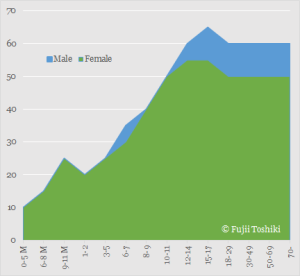The chemical name of vitamin B2 is riboflavin. The Dietary Reference Intakes of vitamin B2 has been set as amount of riboflavin. When vitamin B2 bind to a phosphoric acid, it becomes flavin mononucleotide (FMN). When FMN binds to AMP, it becomes Flavin adenine dinucleotide (FAD). They are both digested and absorbed in vitamin B2 and are shown as the equimolar of activity of vitamin B2.
Vitamin B2 is involved in energy metabolism and substance metabolism as coenzyme FMN and FAD. It is involved in such energy metabolism as TCA cycle, electron transport system and β-oxidation of fatty acids. Vitamin B2 deficiency causes growth suppression, stomatitis, angular cheilitis, glossitis and seborrheic dermatitis.
Most of riboflavin in foods are present as FAD and FMN, they will be released with cooking and gastric acid. The released FAD and FMN are hydrolyzed with FMN phosphatase and FAD pyrophosphatase of small intestine mucosa and absorbed into small intestine epithelial cells by active transport. The relative bioavailability of vitamin B2 in the diet in Japanese is reported 64 %.
Although there are two methods for determining the required amount of vitamin B2, minimum amount necessary to recover from the deficiency and the inflection point of the relationship between intake and urinary excretion, they are not consistent. They thought that the water soluble vitamin are not excreted into the urine until they meet the required amount and urinary excretion is increased rapidly when they exceeds the required amount and have set the inflection point as the required amount. When the intake is greater than 1.1 mg/d, vitamin B2 excretion into the urine is increased depending on the intake (pdf), it is considered as the required amount.
The Estimated Average Requirement and Recommended Amount in adult and child
As vitamin B1, the minimum intake that excretion of vitamin B2 into the urine starts to increase has been set to the Estimated Average Requirement. Because the energy intake in the study was 2,200 kcal/d, the reference to calculate the Estimated Average Requirement in energy intake in 1-69 age is 0.50 mg/1,000 kcal. The Estimated Average Requirement has been calculated by multiplying the reference by the Estimated Energy Requirement in each age groups. The Recommended Amount has been calculated by multiplying the Estimated Average Requirement by recommended amount calculated coefficient 1.2.
The Estimated Average Requirement and Recommended Amount in pregnant
Addition for pregnant has been calculated because the vitamin B2 is increased in response to the energy requirements. Additional energy of pregnant are 50 kcal/d in first trimester, 250 kcal/d in second trimester and 450 kcal/d in third trimester, respectively. The additional amount are multiplied them by the reference of Estimated Average Requirement, 0.50 mg/1,000 kcal, the results are 0.03 mg/d in first trimester, 0.13 mg/d in second trimester and 0.23 mg/d in third trimester, respectively. However, because the energy demand in pregnancy is different in each person and the metabolism enhance especially during pregnancy, the value of late pregnancy has been set to the necessary amount of the entire gestation period. The Estimated Average Requirement of addition for pregnant is rounded to 0.2 mg/d and the Recommended Amount is rounded to 0.3 mg/d, respectively.
The Estimated Average Requirement and Recommended Amount in lactation
The addition for lactation is set to 0.5 mg/d by multiplying the concentration of human milk 0.40 mg/L by milk yield 0.78 L/d and divided by the relative bioavailability of 60 %.
The Approximate Amount in infant
The Approximate Amount of 0-5 months infant is 0.31 mg/d by multiplying the concentration 0.40 mg/L in breast milk by the standard mammalian amount of 0.78 L/d and has been set to 0.3 mg/d by rounding. The Approximate Amount of 6-11 months infant has been set to 0.4 mg/d.
Even if an excess amount is absorbed, excess riboflavin are excreted rapidly into the urine and it is considered that the there is small effect of overdose, then the upper limit has not been set.
| Gender | Male | Female | ||||
|---|---|---|---|---|---|---|
| Age | Estimated Average Requirement | Recommended Amount | Approximate Amount | Estimated Average Requirement | Recommended Amount | Approximate Amount |
| 0-5 M | 0.3 | 0.3 | ||||
| 6-11 M | 0.4 | 0.4 | ||||
| 1-2 | 0.5 | 0.6 | 0.5 | 0.5 | ||
| 3-5 | 0.7 | 0.8 | 0.6 | 0.8 | ||
| 6-7 | 0.8 | 0.9 | 0.7 | 0.9 | ||
| 8-9 | 0.9 | 1.1 | 0.9 | 1.0 | ||
| 10-11 | 1.1 | 1.4 | 1.1 | 1.3 | ||
| 12-14 | 1.3 | 1.6 | 1.2 | 1.4 | ||
| 15-17 | 1.4 | 1.7 | 1.2 | 1.4 | ||
| 18-29 | 1.3 | 1.6 | 1.0 | 1.2 | ||
| 30-49 | 1.3 | 1.6 | 1.0 | 1.2 | ||
| 50-69 | 1.2 | 1.5 | 1.0 | 1.1 | ||
| 70- | 1.1 | 1.3 | 0.9 | 1.1 | ||
| Addition for pregnant | 0.2 | 0.3 | ||||
| Addition for lactation | 0.3 | 0.6 | ||||
| Gender | Male | Female | ||||
|---|---|---|---|---|---|---|
| Age | Estimated Average Requirement | Recommended Amount | Approximate Amount | Estimated Average Requirement | Recommended Amount | Approximate Amount |
| 0-5 M | 0.3 | 0.3 | ||||
| 6-11 M | 0.4 | 0.4 | ||||
| 1-2 | 0.5 | 0.6 | 0.5 | 0.5 | ||
| 3-5 | 0.7 | 0.8 | 0.6 | 0.8 | ||
| 6-7 | 0.8 | 0.9 | 0.7 | 0.9 | ||
| 8-9 | 0.9 | 1.1 | 0.9 | 1.0 | ||
| 10-11 | 1.1 | 1.4 | 1.0 | 1.2 | ||
| 12-14 | 1.3 | 1.5 | 1.1 | 1.4 | ||
| 15-17 | 1.4 | 1.7 | 1.1 | 1.4 | ||
| 18-29 | 1.3 | 1.6 | 1.0 | 1.2 | ||
| 30-49 | 1.3 | 1.6 | 1.0 | 1.2 | ||
| 50-69 | 1.2 | 1.5 | 1.0 | 1.2 | ||
| 70- | 1.1 | 1.3 | 0.9 | 1.1 | ||
| Addition for first trimester | 0.0 | 0.0 | ||||
| Addition for second trimester | 0.1 | 0.2 | ||||
| Addition for third trimester | 0.2 | 0.3 | ||||
| Addition for lactation | 0.3 | 0.4 | ||||
References:
The Dietary Reference Intakes for Japanese (2015 edition) Water solublr vitamin (pdf)
The Dietary Reference Intakes for Japanese (2010 edition) VItamin B2 (pdf)




